Both have white keys, both have black keys, and even in the same arrangement. That is why many laypeople rightly ask, what is the difference between piano and keyboard? Are there things that the keyboard can do, and the digital piano can’t?
It is not easy when you have decided to buy a digital keyboard instrument. On the one hand, there is a huge selection of digital pianos. On the other hand, many are thinking of the possibility of purchasing a very light MIDI keyboard that can be made to sound with the numerous sound libraries available on the market. However, it becomes easier when you make it clear which musical goals you are pursuing in the long term.
The instruments look similar and yet they all have a different name: electric piano, e-piano, digital piano, Clavinova, or keyboard – are there differences or is it always the same instrument? We will shed light into the dark!
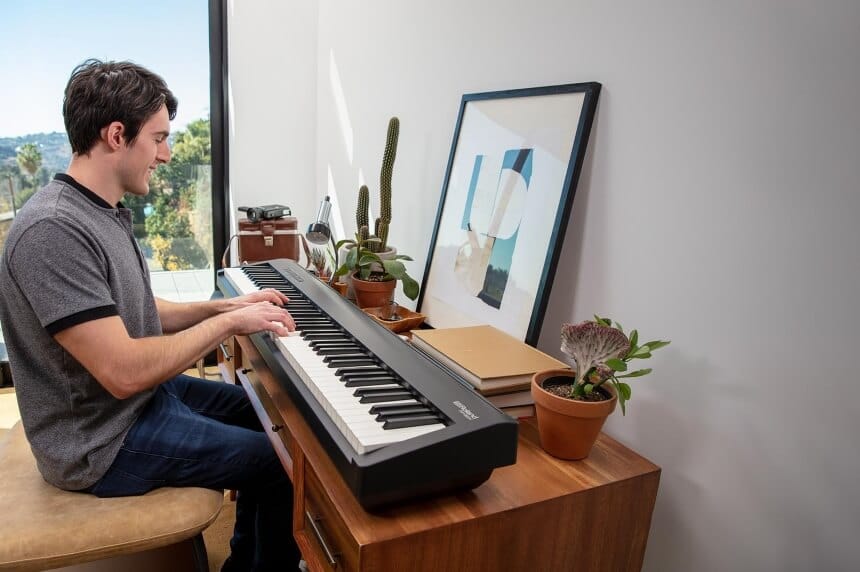 The digital piano is considered to be an electronic replacement for the acoustic piano. In contrast to the mechanical sound generation of the acoustic original using mechanics, strings, and soundboard, with the digital piano, the individual tones of a piano or grand piano are reproduced using digital recording or physical modeling processes and reproduced via integrated amplifier/loudspeaker systems. The technologies of today are very mature, ensuring quite authentic piano and grand piano sounds are achievable.
The digital piano is considered to be an electronic replacement for the acoustic piano. In contrast to the mechanical sound generation of the acoustic original using mechanics, strings, and soundboard, with the digital piano, the individual tones of a piano or grand piano are reproduced using digital recording or physical modeling processes and reproduced via integrated amplifier/loudspeaker systems. The technologies of today are very mature, ensuring quite authentic piano and grand piano sounds are achievable.
Digital pianos are sometimes also referred to as “electric pianos.” This is of course not fundamentally wrong because it is undoubtedly electrical devices that produce piano sounds. However, in the history of electrical and electronic musical instruments, the term “e-piano” stands for the electromechanical pianos of the 1960s and 1970s, of which the Fender Rhodes and the Wurlitzer are the best-known models. To create a clear distinction here, the more precise term “digital pianos” is used for today’s digital instruments.
A good digital piano can be recognized by a well-playable, weighted hammer-action keyboard. It must produce good sound via the integrated amplifier/loudspeaker system. One of the best or most sold digital pianos is the Yamaha Arius YDP-103. It’s an 88-key digital home piano with a bench and graded hammer keyboard.
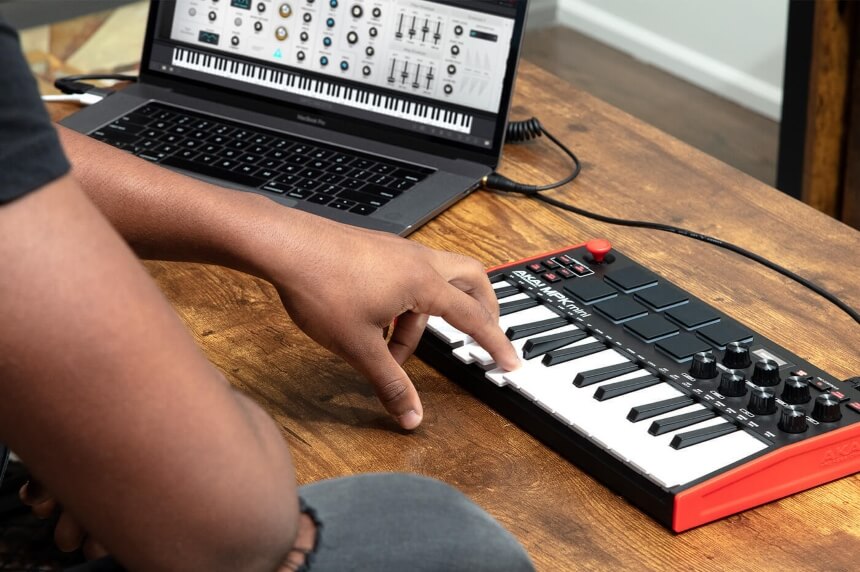 MIDI keyboards are also called midi controllers or master keyboards. There are 25, 49, 61, 76, and 88 keys. As shocking as it may seem to someone who is not familiar, these keyboards do not produce sound, that is, they do not have any sound “in”. They are designed to be connected to a computer and that it is the computer that gives the sound that the user wants.
MIDI keyboards are also called midi controllers or master keyboards. There are 25, 49, 61, 76, and 88 keys. As shocking as it may seem to someone who is not familiar, these keyboards do not produce sound, that is, they do not have any sound “in”. They are designed to be connected to a computer and that it is the computer that gives the sound that the user wants.
A MIDI keyboard is used to control other electronic music devices or virtual instruments – for example, a computer on which instrument software is installed. The MIDI keyboard thus serves as an input aid or additional processing device, whereby “MIDI” is the technology of data transmission. One of the areas of application is home recording. One of the best produced MIDI keyboards is the Alesis V49. It is a powerful and intuitive MIDI controller with series of pads, buttons, and knobs.
The data is transmitted either via a USB connection or via MIDI sockets from the MIDI output (MIDI-Out) of the MIDI keyboard to the MIDI input (MIDI-In) of a second device. The device sending the information (MIDI keyboard) is called the “master” and the receiving device (computer) is called the “slave”. MIDI keyboards are therefore often referred to directly as master keyboards. Trusted Source Thomann Online Guides What is a master keyboard? Controller Keyboards – Thomann UK Competent Online Guides at www.thomann.de What is a master keyboard? Controller Keyboard m.thomann.de
In addition to the MIDI-Out and MIDI-In connections, there is also “MIDI-Thru”. This connection is used if an additional, third device is to be controlled. For example: two synthesizers are to be controlled from a MIDI keyboard. The connection then runs from the MIDI out of the master keyboard to the MIDI in synthesizer 1. Synthesizer 2 is also connected to synthesizer 1 via the MIDI thru the connector of synthesizer 1 to the MIDI in the connector of synthesizer 2. “MIDI-Thru” is used to forward information received via the MIDI-In unprocessed.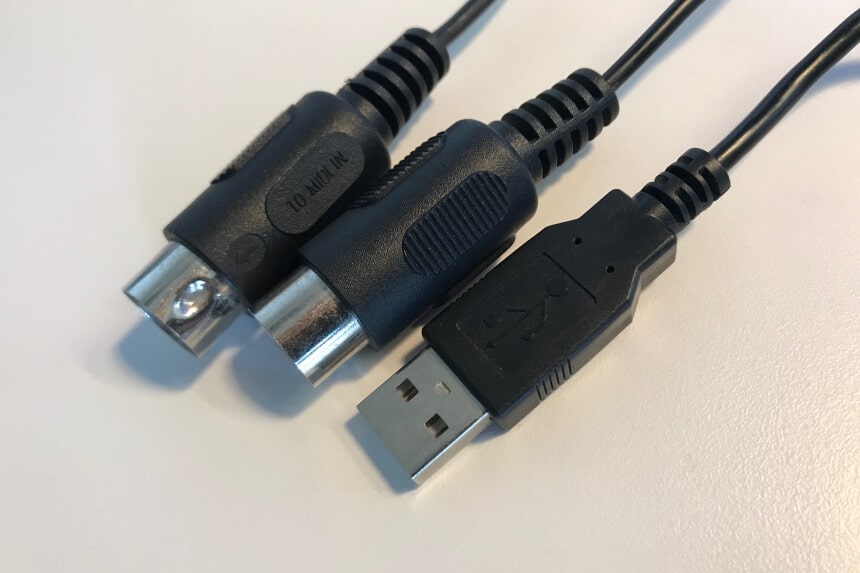
Pianos and keyboards look similar physically but the modes with which they work are different. Find out below how they both differ.
The action in these two musical instruments describes how the keys respond when they are pushed down. Being an acoustic item, pianos have better action and also a weighted feel when you are playing. Meanwhile, keyboards with weighted keys are ideal for students who want keyboards that feel like a piano.
The piano and keyboard have similar key arrangements. Meanwhile, pianos use similar width of keys and keyboards have identical and narrower widths of keys. The slight changes in the key width aren’t a determining factor in deciding the best and will also not take a long time of getting used to.
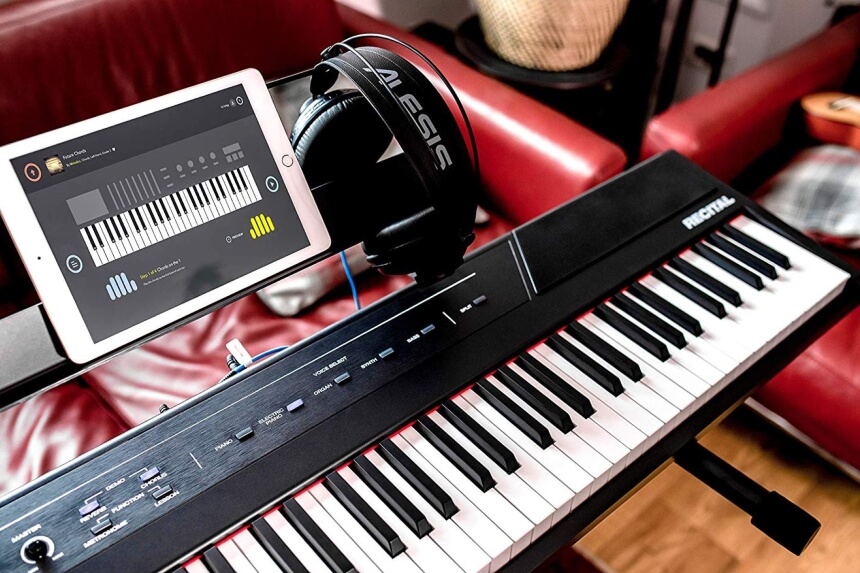 While standard pianos
usually have 88 keys
Trusted Source
How to Buy a Keyboard: 8 Steps (with Pictures) - wikiHow
Developed in 1964 by Robert Moog, the modular synthesizer was the first of a generation of electronic musical keyboards, followed in 1970 by the first performance model. Thanks to advances in electronics since then, digital keyboards are…
www.wikihow.com
, MIDI keyboard controllers are offered in different sizes. Often the same model is available in several sizes. The usual keyboard sizes are 25 keys (2 octaves), 49 keys (4 octaves), 61 keys (5 octaves), and 88 keys (piano size, often with hammer action). Keyboards with 37 keys (3 octaves) and 76 keys are also rarely found. Which is the right size depends on various factors. If you play pianistically with both hands, you need a larger keyboard with 61, 76, or 88 keys and you will probably also enjoy a hammer mechanism that is almost only available on keyboard controllers with 88 keys.
While standard pianos
usually have 88 keys
Trusted Source
How to Buy a Keyboard: 8 Steps (with Pictures) - wikiHow
Developed in 1964 by Robert Moog, the modular synthesizer was the first of a generation of electronic musical keyboards, followed in 1970 by the first performance model. Thanks to advances in electronics since then, digital keyboards are…
www.wikihow.com
, MIDI keyboard controllers are offered in different sizes. Often the same model is available in several sizes. The usual keyboard sizes are 25 keys (2 octaves), 49 keys (4 octaves), 61 keys (5 octaves), and 88 keys (piano size, often with hammer action). Keyboards with 37 keys (3 octaves) and 76 keys are also rarely found. Which is the right size depends on various factors. If you play pianistically with both hands, you need a larger keyboard with 61, 76, or 88 keys and you will probably also enjoy a hammer mechanism that is almost only available on keyboard controllers with 88 keys.
Digital pianos sound better as they have built-in speakers and the other doesn’t make sound but amplifies it. Today, MIDI keyboards are more chosen for sound purposes. While MIDI keyboards don’t produce sound, digital pianos produce sound. MIDI keyboards require amplifiers for sound projection. This information is sent from the keyboard to the software for music production on the computer. It can consist, for example, of the height of a tone, the velocity of the tone, and the duration of the tone. So no sound and thus no audio file is transmitted from the MIDI keyboard to the connected device, but only individual information for the definition of a sound.
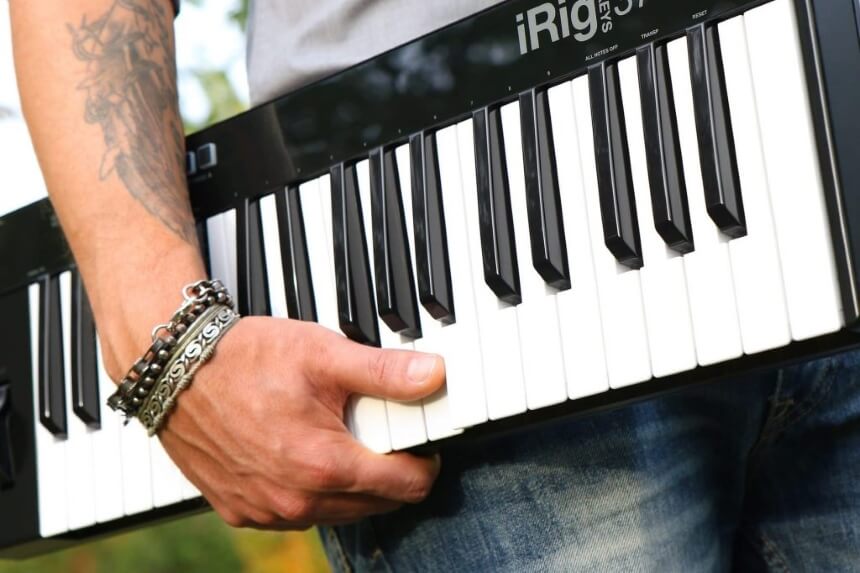 Digital pianos are usually heavier and sizable than MIDI keyboards for several reasons. First, most pianos come in 88 keys, therefore, taking away the portability. Meanwhile, there are MIDI keyboards with just 25 keys. So, if you want portability, you have a lot of choices with MIDI keyboards.
Digital pianos are usually heavier and sizable than MIDI keyboards for several reasons. First, most pianos come in 88 keys, therefore, taking away the portability. Meanwhile, there are MIDI keyboards with just 25 keys. So, if you want portability, you have a lot of choices with MIDI keyboards.
Digital pianos can be a little bit costlier than MIDI keyboards, due to the higher number of keys, integration of speakers, and other technical inputs.
If you want to learn to play the piano with lasting success and joy, you need an acoustic instrument. Because only on an acoustic piano or grand piano is the hearing trained and playing technique and creativity able to develop. The possibility of shaping the tone, the natural sound, and the controllable playing style speak for the acoustic instruments. Anyone who has ever played an acoustic instrument will not want to miss this unique feeling anymore. However, they can be more expensive than the digital pianos and MIDI keyboards, but for the right reasons!
Of course, digital pianos also have certain advantages: If you tend to play pop music and are often on the go and would like to take your instrument with you, you will find a compromise in modern electric pianos. The sound of digital pianos has improved in recent years – but there are limits: digital recordings (so-called samples) of individual tones are stored in a digital piano.
Often only every third tone is recorded with a few volume levels. The other tones are digitally calculated and simulated.
The complex experience of playing an acoustic instrument cannot be achieved even with the most sophisticated digital technology. While the keys on an electric piano look similar to their acoustic counterparts, the weight and the touch are often much lighter and offer less control.
Digital piano or MIDI keyboard with sound libraries – the intended use decides what is the best solution for you. If you focus on practicing, a digital piano with a good keyboard, hammer mechanism, and sophisticated sound radiation is probably the best solution. Since most digital pianos nowadays are equipped with a MIDI connection, you can also use it to control the sound libraries if you wish. If you are looking for a compact solution for sound design or composing, you will be happy with a MIDI keyboard setup. As you may have noted, the main difference between piano and keyboard is in the mode of producing sound. MIDI keyboards produce sound data, sends it to a MIDI receiver which projects to a speaker, while digital pianos produce the sound and projects with its built-in speakers.
I’ve always wondered what the difference is between a piano and a keyboard. This article explained it really well! I think I might go for a digital piano with a good keyboard and sound system, like the Yamaha Arius YDP-103. It sounds like a great option for practicing and playing music at home.